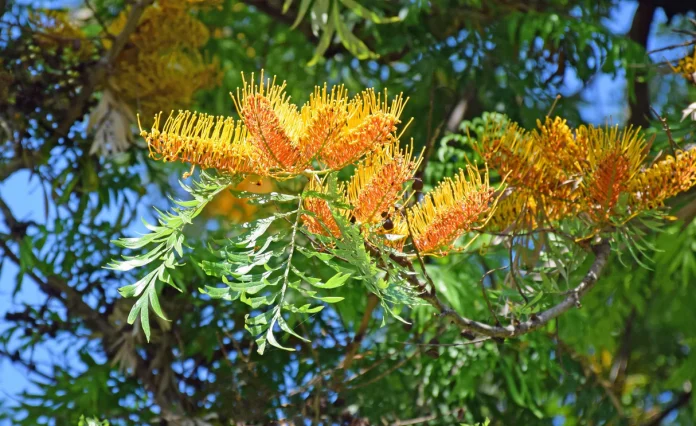The Golden Goliath: Unveiling the Silky Oak’s Secrets
Walking beneath a canopy of golden blooms, dappled sunlight painting the ground beneath, you’d be forgiven for thinking you’d stumbled into a fairytale. But this isn’t magic, it’s the enchanting allure of the Silky Oak (Grevillea robusta), a true giant of the plant world and a fascinating member of the Proteaceae family.
Native to Australia’s sunny east coast, the Silky Oak isn’t an oak at all, but a close relative of the iconic Australian Proteaceae, like Banksias and Macadamias. Like its cousins, the Silky Oak belongs to a plant family known for its ancient lineage and striking, often unusual, floral displays. And when it comes to floral grandeur, the Silky Oak certainly doesn’t disappoint.
Reaching heights of up to 40 meters (130 feet), this evergreen giant boasts a majestic presence with its dark green, fern-like foliage. But the real showstopper comes in spring when the tree bursts into a vibrant display of golden-orange, toothbrush-shaped flowers. These blooms, rich in nectar, attract a flurry of pollinators, creating a buzzing symphony of bees, birds, and butterflies.
But the Silky Oak’s allure goes beyond its aesthetic appeal. Its wood, prized for its beautiful grain and reddish-brown hue, finds use in furniture making, cabinetry, and even musical instruments. The timber’s strength and durability have also made it a popular choice for fencing and building materials.
Despite its grandeur, the Silky Oak is surprisingly adaptable. It thrives in a variety of climates, tolerating drought conditions and even light frost. This resilience, combined with its rapid growth rate, has made it a popular choice for reforestation projects worldwide, particularly in tropical and subtropical regions.
However, the Silky Oak’s journey beyond its native Australia hasn’t been without challenges. In some areas, it has shown invasive tendencies, outcompeting native species. This highlights the importance of careful consideration and responsible planting practices when introducing the Silky Oak to new environments.
Stepping back to admire this botanical marvel, one can’t help but feel a sense of awe. The Silky Oak, with its stunning beauty, versatile nature, and intriguing family ties, serves as a reminder of the remarkable diversity and resilience of the natural world. So, next time you encounter this golden giant, take a moment to appreciate its splendor and the fascinating story it whispers through its leaves and blooms.



